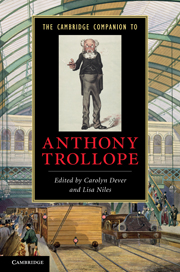Book contents
- Frontmatter
- Introduction
- 1 Trollope’s Literary Life and Times
- 2 Trollope As Autobiographer And Biographer
- 3 Trollope’s Barsetshire Series
- 4 The Palliser Novels
- 5 Trollope Redux: The Later Novels
- 6 Trollope’s Short Fiction
- 7 Trollope And The Sensation Novel
- 8 Queer Trollope
- 9 The hobbledehoy in Trollope
- 10 The construction of masculinities
- 11 Vulgarity and money
- 12 Trollope and the law
- 13 Trollope and travel
- 14 Trollope and the Antipodes
- 15 Trollope and Ireland
- 16 Trollope and America
- Further reading
- Index
- Cambridge Companions to . . .
9 - The hobbledehoy in Trollope
Published online by Cambridge University Press: 28 March 2011
- Frontmatter
- Introduction
- 1 Trollope’s Literary Life and Times
- 2 Trollope As Autobiographer And Biographer
- 3 Trollope’s Barsetshire Series
- 4 The Palliser Novels
- 5 Trollope Redux: The Later Novels
- 6 Trollope’s Short Fiction
- 7 Trollope And The Sensation Novel
- 8 Queer Trollope
- 9 The hobbledehoy in Trollope
- 10 The construction of masculinities
- 11 Vulgarity and money
- 12 Trollope and the law
- 13 Trollope and travel
- 14 Trollope and the Antipodes
- 15 Trollope and Ireland
- 16 Trollope and America
- Further reading
- Index
- Cambridge Companions to . . .
Summary
We know Trollope as chronicler of the clergy, the parliament, and the Civil Service. Critics account for the form of his novels and his understanding of characterization, in fact, in terms of the category of “career” that was coming into its fore in England with the rise of professionalism in the nineteenth century – the self as determined and linearly plotted by the trajectory of a profession, the very notion of identity disciplined and shaped by institutions such as the Church or government. In Trollope’s novels, however, there is always a contrary fantasy. His novels also contain famous accounts of awkward youth – his “hobbledehoys” – who, no matter how much they want to fit in, remain de trop. They’re terrible at their jobs, gauche in company – they cannot fit themselves onto any kind of straightforward path. They are sidetracked or arrested or just plain fail, even when it comes to the kind of basic development – such as growing up – that we think ought to unfold naturally.
These young ne’er-do-wells keep showing up in Trollope’s novels – Trollope identifies Charley Tudor in The Three Clerks (1857) and Johnny Eames in The Small House at Allington (1864) and The Last Chronicle of Barset (1867) as hobbledehoys. But this kind of backward and ineffective young man appears throughout Trollope’s fiction often and in many guises. Readers recognize that hobbledehoys seem close to Trollope’s heart; the partiality with which he regards them, we think, must tell us something important about Trollope’s narrative intentions or social appraisal. But – just as with their parents, friends, and superiors in Trollope’s novels – it can be hard for readers to know what to do with such young men.
- Type
- Chapter
- Information
- The Cambridge Companion to Anthony Trollope , pp. 113 - 127Publisher: Cambridge University PressPrint publication year: 2010
- 1
- Cited by

